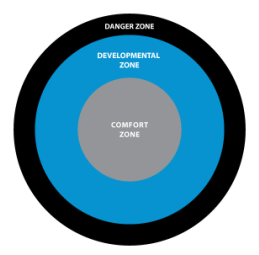If it doesn’t challenge you it doesn’t change you! No Pain, No Gain! Pain is weakness leaving the body! and so on, and so forth. Cheerleader coaches have been hollering these sayings and others like them for decades. And while there is truth to the fact that we must challenge ourselves in order to elicit adaptation, we must also acknowledge that MORE is not always BETTER. At Prototyps Sports Performance, we believe it is critical to acknowledge where development ends and where diminished performance and risk of injury begins.

The above illustration of the athletic development paradigm, often used to help athletes understand where they are in their current state of well-being, is broken into three zones: comfort, development, danger. By understanding each of these zones, athletes and coaches can better optimize not only development, but performance as well. The characteristics of each zone are:
Comfort Zone
In this zone no development takes place, since we are not placed under significant enough stress to elicit an adaptive response. In the weight room this equates to performing sets and reps at too low an intensity, while in sport this would be akin to spending all of your time on drills long mastered, or constantly playing inferior competition. Though there are times when low level/intensity skill work has its benefits, any athlete attempting to better themselves does not want to spend much time in the comfort zone.
Danger Zone
In this zone development is also hindered, but more importantly athletes become at risk. It is in this zone where it is irresponsible of coaches, who’s first job is to do no harm, to ask athletes to training. The danger zone can be reached either gradually, or acutely.
- Gradual entry into the danger zone occurs when athletes are asked to train at too high of an intensity, for extended periods of time, without regard for outside stressors, or proper recovery. This can happen in the gym, through an inproperly monitored training program, focused on the all-or-nothing, work til you puke mentality, or through inadequate monitoring of game/practice work to rest ratios. In hockey we often see it rear its ugly head with the dreaded “suicides” (even the name is negative) punishment usually justified as “getting in better shape.” Spending too much time in the danger zone can result in non-functional over reaching, or worse burnout cause by overtraining (both discussed here), and can mask itself as fatigue, “out of shape,” or in many cases, non-contact injuries (eg. groin/hip flexor pulls, ligament tears, hamstring injury).
- Acute entry to the danger zone can often be harder to avoid for athletes. This stems from the far to prevalent “coach knows best” mindset that permeates the throughout the sports world. Acute entry happens when athletes attempt to do too much, too soon. This can be via too steep of an increase in workload (which shocks the central nervous system), attempting more advanced techniques without mastery of the underlying principles, or failure to identify restrictions that may lead to breakdown. I often refer to acute entry as ego driven, either on the part of the coach or the athlete and usually comes down to a lack of knowledge, or failure to acknowledge a lack of knowledge. The outcomes of acute entry into the danger zone can be catastrophic and completely derail a training program, or even a career. I do not want to overstate this, but as a coach placing athletes at unnecessary risk is UNACCEPTABLE!
Coaches, players and parents are all responsible for helping athletes stay out of the danger zone.
Development Zone
Just like Goldilocks and the Three Bears, this is where we get fed! The development zone is where learning and adaptation takes place. It is achieved by pushing beyond our comfort zone (but not too far), challenging our mind and body and then taking a step back to allow for adequate processing and adaptation to take place. The development zone is most efficiently reached when we view the athlete globally, meaning we take into account all of the variables that effect the individual, both internally and externally. We then plan according to that particular athletes ability and readiness levels, but are flexible enough to alter the game-plan depending on changes to those same variables, or the addition of new ones (eg. injury, exams, game schedule). We achieve this level of training through the use of diagnostic tools, proper recovery strategies and most importantly, open, candid communication between all parties involved, with the athlete at the center.
This is a brief-ish overview of the developmental zones utilized here at Prototype Sports Performance. However, it is important to note that these zones are not fixed, but rather they shift along with your development. What was once your development zone, will become your comfort zone through consistency and dedication to the process. Conversely, what was once your development zone, can quickly become your new danger zone without proper planning, awareness and communication. Remember Smart Hard Training > Dumb Hard Training! #BeThePrototype
About the Author
Justin Vince is the founder of Prototype Sports Performance in Mississauga, ON. In addition to being a Certified Strength and Conditioning Specialist, Justin is also a member of the Ontario College of Teachers. Justin is passionate learner and coach, who also enjoys picking up heavy things.
Like what you read? Follow him on Twitter and Instagram @Coach_JVince.



